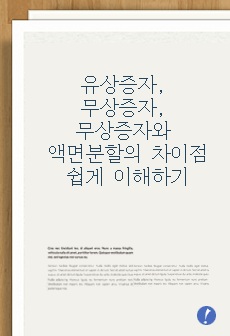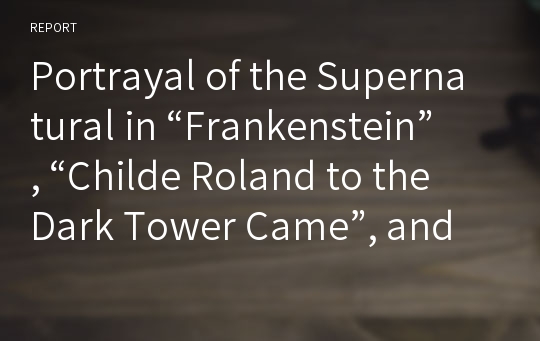Portrayal of the Supernatural in “Frankenstein”, “Childe Roland to the Dark Tower Came”, and “the Lady of Shalott”
*하*
다운로드
장바구니
소개글
Frankenstein, which was written by British woman writer Mary Shelley in 1818, includes various social phenomena of Victorian era such as supernaturalism, social class, development of science, colonialism and so forth. Among these, the supernatural element makes the greatest contribution to the success of Frankenstein, impressing the readers with the innocent and evil sides of the creature. Both “Childe Roland to the Dark Tower Came” (1855) by Robert Browning and “The Lady of Shalott” (1842) written by Tennyson are also the representative Victorian works of supernatural. Through this essay, Frankenstein will be analyzed in terms of the portrayal of supernatural comparing with above two works.목차
없음본문내용
Frankenstein, which was written by British woman writer Mary Shelley in 1818, includes various social phenomena of Victorian era such as supernaturalism, social class, development of science, colonialism and so forth. Among these, the supernatural element makes the greatest contribution to the success of Frankenstein, impressing the readers with the innocent and evil sides of the creature. Both “Childe Roland to the Dark Tower Came” (1855) by Robert Browning and “The Lady of Shalott” (1842) written by Tennyson are also the representative Victorian works of supernatural. Through this essay, Frankenstein will be analyzed in terms of the portrayal of supernatural comparing with above two works.By analyzing Victorian`s works, I could have a glimpse on their culture and ideology at that time. All these three works had different unique color and flavor which allowed me to have a fresh mood as appreciating one another. For all that, it was Frankenstein that impressed me most with the appearance of the pathetic monster. Even I felt sorry for the fact that `the creature` had been called as `Frankenstein` which was not actually his name but the foe`s. He was made to satisfy human beings` desire, but he had to be abandoned for the imperfection of the appearance. At the end of the story, he even says; "Yet I seek not a fellow feeling in my misery. No sympathy may I ever find. When I first sought it, it was the love of virtue, the feelings
참고 자료
[1] Blamires, Harry. (1992) “The Victorian Age of Literature” Longman Group UK[2] Browning, Robert. (1855) “Childe Roland to the Dark Tower Came”
[3] Goss, Theodora and John Paul Riquelme. (2007) “From superhuman to posthuman: the gothic technological imaginary in Mary Shelley’s Frankenstein and Octavia butler’s xenogenesis” The Johns Hopkins University Press
[4] Shelley, Mary. (1818) “Frankenstein, or the Modern Prometheus”
[5] Tennyson, Alfred. (1842) “The Lady of Shalott”


























